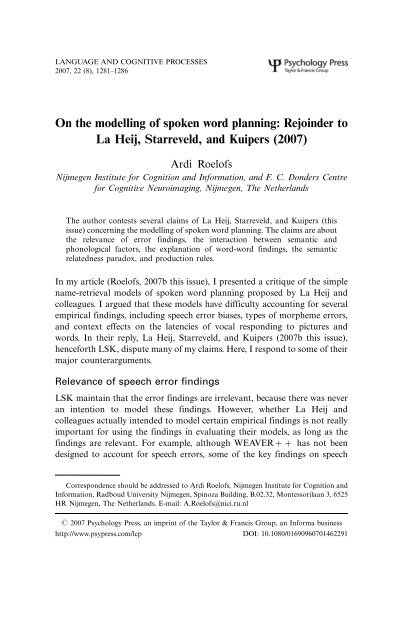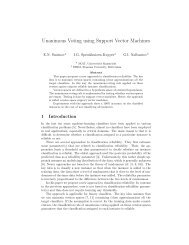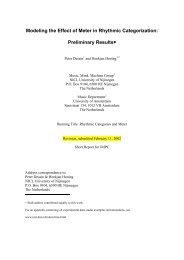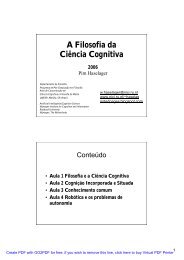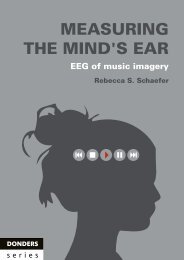Article (PDF 60K) - Donders Institute for Brain, Cognition and ...
Article (PDF 60K) - Donders Institute for Brain, Cognition and ...
Article (PDF 60K) - Donders Institute for Brain, Cognition and ...
Create successful ePaper yourself
Turn your PDF publications into a flip-book with our unique Google optimized e-Paper software.
LANGUAGE AND COGNITIVE PROCESSES<br />
2007, 22 (8), 12811286<br />
On the modelling of spoken word planning: Rejoinder to<br />
La Heij, Starreveld, <strong>and</strong> Kuipers (2007)<br />
Ardi Roelofs<br />
Nijmegen <strong>Institute</strong> <strong>for</strong> <strong>Cognition</strong> <strong>and</strong> In<strong>for</strong>mation, <strong>and</strong> F. C. <strong>Donders</strong> Centre<br />
<strong>for</strong> Cognitive Neuroimaging, Nijmegen, The Netherl<strong>and</strong>s<br />
The author contests several claims of La Heij, Starreveld, <strong>and</strong> Kuipers (this<br />
issue) concerning the modelling of spoken word planning. The claims are about<br />
the relevance of error findings, the interaction between semantic <strong>and</strong><br />
phonological factors, the explanation of word-word findings, the semantic<br />
relatedness paradox, <strong>and</strong> production rules.<br />
In my article (Roelofs, 2007b this issue), I presented a critique of the simple<br />
name-retrieval models of spoken word planning proposed by La Heij <strong>and</strong><br />
colleagues. I argued that these models have difficulty accounting <strong>for</strong> several<br />
empirical findings, including speech error biases, types of morpheme errors,<br />
<strong>and</strong> context effects on the latencies of vocal responding to pictures <strong>and</strong><br />
words. In their reply, La Heij, Starreveld, <strong>and</strong> Kuipers (2007b this issue),<br />
hence<strong>for</strong>th LSK, dispute many of my claims. Here, I respond to some of their<br />
major counterarguments.<br />
Relevance of speech error findings<br />
LSK maintain that the error findings are irrelevant, because there was never<br />
an intention to model these findings. However, whether La Heij <strong>and</strong><br />
colleagues actually intended to model certain empirical findings is not really<br />
important <strong>for</strong> using the findings in evaluating their models, as long as the<br />
findings are relevant. For example, although WEAVER has not been<br />
designed to account <strong>for</strong> speech errors, some of the key findings on speech<br />
Correspondence should be addressed to Ardi Roelofs, Nijmegen <strong>Institute</strong> <strong>for</strong> <strong>Cognition</strong> <strong>and</strong><br />
In<strong>for</strong>mation, Radboud University Nijmegen, Spinoza Building, B.02.32, Montessorilaan 3, 6525<br />
HR Nijmegen, The Netherl<strong>and</strong>s. E-mail: A.Roelofs@nici.ru.nl<br />
# 2007 Psychology Press, an imprint of the Taylor & Francis Group, an In<strong>for</strong>ma business<br />
http://www.psypress.com/lcp DOI: 10.1080/01690960701462291
1282 ROELOFS<br />
errors have motivated assumptions made in the model, such as the<br />
assumption of levels of lemmas <strong>and</strong> phonemes. These error-motivated<br />
assumptions have determined the per<strong>for</strong>mance of WEAVER in simulations<br />
of results on response times. Thus, I maintain that error findings are<br />
relevant <strong>for</strong> evaluating the name retrieval models. LSK now seem to accept<br />
that phonemes are involved in spoken word planning. I note that this<br />
involves a change of the (implicit) theory underlying the name retrieval<br />
models. If the change of theory is endorsed, the simulation results reported<br />
by La Heij <strong>and</strong> colleagues in several articles can no longer be taken as<br />
support <strong>for</strong> the name retrieval models.<br />
LSK seem to believe that phonemes can be included in the name retrieval<br />
models without a cost. However, this remains to be demonstrated. For<br />
example, Peterson, Dell, <strong>and</strong> O’Seaghdha (1989) presented simulations of<br />
phonological effects of written word distractors on picture naming latencies<br />
using a model consisting of letter, lexical, <strong>and</strong> phoneme nodes. Selection of<br />
phoneme nodes was based on level of activation only, as in the name retrieval<br />
models. Thus, an extension of the name retrieval models with phoneme<br />
nodes would presumably be similar to this model of Peterson et al.<br />
Simulations revealed that the model had great difficulty in selecting the<br />
correct phoneme nodes in the context of written distractors. In some<br />
distractor conditions, the error percentage was about 50%, whereas the real<br />
error percentage is typically below 5%. To account <strong>for</strong> the latency effects in<br />
the absence of a massive amount of errors, Peterson et al. suggested that the<br />
latency effects were due to error monitoring <strong>and</strong> repair, although they did<br />
not specify how this worked. In contrast, Roelofs (1997) showed how<br />
WEAVER explains the data. Thus, the challenge <strong>for</strong> LSK is to<br />
demonstrate that the name retrieval models with phoneme selection do<br />
not suffer from the problems that confront models such as those of Peterson<br />
et al. (1989).<br />
Accounting <strong>for</strong> the word-word findings<br />
LSK reject my claim that the name retrieval models cannot account <strong>for</strong><br />
Stroop-like effects in the word-word task. They argue that the word-word<br />
effects reflect perceptual interference rather than response competition.<br />
Under the perceptual interference account, distractor word FISH interferes<br />
with reading aloud DOG compared to XXX, whereas DOG as distractor<br />
speeds up the reading of DOG. This is because the distractor FISH yields<br />
interference in the perceptual processing of DOG whereas the distractor<br />
DOG helps perceptual processing. However, the perceptual account fails to<br />
explain why response-set effects may be obtained in the word-word task<br />
(Glaser & Glaser, 1989). For example, if fish is a response <strong>and</strong> bird is not,
FISH may yield more interference than BIRD. This suggests that the effects<br />
arise during response selection (Roelofs, 2003a).<br />
Interaction between semantic <strong>and</strong> phonological factors<br />
LSK contest my claim that the findings of Damian <strong>and</strong> Martin (1999) pose<br />
problems to the name retrieval models by arguing that these findings need to<br />
be replicated first. I have not attempted to replicate these findings, but I have<br />
conducted experiments that are closely related (yet unpublished data,<br />
described in Roelofs, 2005). According to WEAVER, the interaction<br />
between semantic <strong>and</strong> phonological relatedness occurs because a mixed<br />
distractor (e.g., donkey) activates the target (e.g., dolphin) as cohort member.<br />
Research on spoken word recognition has shown that word c<strong>and</strong>idates are<br />
activated to the extent that their initial phonemes are shared (see Roelofs,<br />
2003b, <strong>for</strong> a review). Thus, whereas the cohort competitor donkey should<br />
yield the interaction in naming a dolphin, the rhyme competitor robin should<br />
not. In replicating the experiment of Damian <strong>and</strong> Martin (1999) using rhyme<br />
competitors, I obtained the regular semantic interference <strong>and</strong> phonological<br />
facilitation effects but no interaction. This result supports WEAVER<br />
<strong>and</strong> challenges the name retrieval models.<br />
Semantic relatedness paradox<br />
MODELLING OF WORD PLANNING 1283<br />
In an English-to-Dutch word translation task, distractor pictures yield<br />
semantic facilitation, whereas Dutch distractor words yield semantic<br />
interference. LSK argue at length that WEAVER is unable to simulate<br />
this finding. However, the verbal description of why WEAVER<br />
presumably fails is not convincing. Given the complexity of the experimental<br />
situation <strong>and</strong> the number of factors involved, computer simulations would be<br />
critical. I have there<strong>for</strong>e per<strong>for</strong>med these simulations. The simulations were<br />
equivalent to those reported in Roelofs (1992, 2003a, 2006), except that each<br />
concept (e.g., DOG(X)) was connected to two lemmas, one <strong>for</strong> each language<br />
(i.e., Dutch hond, English dog). Word translation began by activating the<br />
lemma of the to-be-translated English word (e.g., dog), which was followed<br />
by the selection of the corresponding concept. Finally, the lemma of the<br />
Dutch translation equivalent (hond) was selected. Picture distractors were<br />
simulated by activating the corresponding concept nodes <strong>and</strong> Dutch word<br />
distractors were simulated by activating the corresponding lemma nodes. The<br />
response selection threshold was 1.0, <strong>and</strong> the distractor duration was 125 ms<br />
<strong>for</strong> pictures <strong>and</strong> 150 ms <strong>for</strong> words (this difference is not crucial, but served to<br />
optimise the fit). Because of the requirement to include two languages, there<br />
were twice as many lemma nodes than in the simulations of Roelofs (1992,<br />
2003a, 2006). There<strong>for</strong>e, the overall spreading rate was reduced by half. In<br />
the simulations, picture distractors yielded 27 ms semantic facilitation <strong>and</strong>
1284 ROELOFS<br />
word distractors yielded 23 ms semantic interference. The real facilitation<br />
<strong>and</strong> interference effects were both 28 ms in Experiment 1 of Bloem <strong>and</strong> La<br />
Heij (2003). The simulations demonstrate that the semantic relatedness<br />
paradox in word translation may occur in WEAVER, in contrast to<br />
what LSK claim. Latency effects of distractors in WEAVER are the<br />
outcome of intricate processing interactions within the word production<br />
architecture (e.g., Roelofs, 1992, 2003a, 2006). LSK mention a number of<br />
factors that may influence the latency outcome, such as network distance, but<br />
they ignore that the presence of two languages in a translation task may also<br />
have an effect.<br />
Production rules<br />
LSK notice that even after accepting the theoretical changes to the name<br />
retrieval models that I proposed, several important theoretical differences<br />
still remain between the name retrieval models <strong>and</strong> WEAVER. In<br />
particular, WEAVER employs condition-action production rules,<br />
whereas the name retrieval models do not. LSK hold that the problem<br />
with production rules is that they result in error-free per<strong>for</strong>mance, lack<br />
independent motivation, <strong>and</strong> provide no insight.<br />
Although it is true that WEAVER made no errors in most<br />
simulations (likewise, the error percentages in the simulated experiments<br />
were very low <strong>and</strong> typically followed the response time patterns), the model<br />
has been applied to error findings (Roelofs, 1992, 1997, 2003a, 2004, 2005)<br />
<strong>and</strong> has simulated error data (Levelt et al., 1999). Errors may occur in the<br />
model when noise is present in the production rule application. This account<br />
of errors may be extended by allowing <strong>for</strong> partial production rule matching<br />
(cf. Anderson, 1983). Although WEAVER may accept partial matches,<br />
it should prefer a full match to a partial match. Errors may occur because of<br />
goal neglect. Initial explorations of partial production rule matching in<br />
WEAVER through computer simulations suggested that partial matching<br />
not only does a good job in accounting <strong>for</strong> error patterns, but also <strong>for</strong> the<br />
latency effects of message <strong>and</strong> response congruency referred to by LSK.<br />
According to LSK, another problem with production rules is that they<br />
lack independent motivation <strong>and</strong> provide no insight. It is not completely<br />
clear what LSK mean by a lack of independent motivation. Production rules<br />
do not lack neural plausibility. Evidence from single cell recordings <strong>and</strong><br />
functional brain imaging studies suggests that primate prefrontal cortex is<br />
implicated in the retrieval, implementation, <strong>and</strong> maintenance of conditionaction<br />
rules (e.g., Bunge, 2004; Bunge, Kahn, Wallis, Miller, & Wagner, 2003;<br />
Wallis, Anderson, & Miller, 2001). Moreover, the critique of LSK that<br />
production rules do not really provide insight misses a principled motivation.<br />
The use of production rules is grounded in a long explanatory tradition in
MODELLING OF WORD PLANNING 1285<br />
psychology (e.g., Allport, 1980; Anderson, 1983; Anderson, Bothell, Byrne,<br />
Douglas, Lebiere, & Qin, 2004; Logan, 1985; Meyer & Kieras, 1997; Newell,<br />
1990). Rejecting production rules, as LSK seem to do, amounts to the<br />
rejection of this successful tradition.<br />
The task-activation approach that LSK advocate as an alternative to<br />
production rules may perhaps h<strong>and</strong>le some simple, limited task situations,<br />
but it is inadequate in dealing with more complex circumstances (e.g.,<br />
Roelofs, 2003a, 2007a). It seems that the task-activation approach of LSK<br />
can only be endorsed at the cost of oversimplifying experimental situations.<br />
Unlike what I described above <strong>for</strong> WEAVER, Bloem <strong>and</strong> La Heij (2003)<br />
simulated word translation by providing the equivalent of picture input to<br />
the network of the discrete name-retrieval model, thereby making picture<br />
naming <strong>and</strong> word translation equivalent. However, the task was word<br />
translation, not picture naming. Moreover, the lexical phonological nodes of<br />
only one language (Dutch) were present in their simulations. By treating<br />
word translation as monolingual picture naming, Bloem <strong>and</strong> La Heij (2003)<br />
avoided the need to address the problem of how their model manages to<br />
select the lexical phonological node of a Dutch translation equivalent as<br />
response rather than the lexical phonological node of the English input word<br />
itself, which may be activated higher than the translation equivalent. Thus,<br />
the task-activation approach is insufficient even <strong>for</strong> the situations it was<br />
designed to explain.<br />
To conclude, the counterarguments of LSK do not refute my claim that<br />
existing data challenge the name retrieval models. It remains to be<br />
demonstrated (preferably by computer simulations) that new, modified<br />
versions of the name retrieval models can account <strong>for</strong> the problematic<br />
findings.<br />
REFERENCES<br />
Allport, D. A. (1980). Patterns <strong>and</strong> actions: Cognitive mechanisms are content-specific. In G.<br />
Claxton (Ed.), Cognitive psychology: New directions (pp. 2664). London: Routledge & Kegan<br />
Paul.<br />
Anderson, J. R. (1983). The architecture of cognition. Cambridge, MA: Harvard University Press.<br />
Anderson, J. R., Bothell, D., Byrne, M. D., Douglas, S., Lebiere, C., & Qin, Y. (2004). An integrated<br />
theory of the mind. Psychological Review, 111, 10361060.<br />
Bloem, I., & La Heij, W. (2003). Semantic facilitation <strong>and</strong> semantic interference in word<br />
translation: Implications <strong>for</strong> models of lexical access in language production. Journal of<br />
Memory <strong>and</strong> Language, 48, 468488.<br />
Bunge, S. A. (2004). How we use rules to select actions: A review of evidence from cognitive<br />
neuroscience. Cognitive, Affective, <strong>and</strong> Behavioral Neuroscience, 4, 564579.<br />
Bunge, S. A., Kahn, I., Wallis, J. D., Miller, E. K., & Wagner, A. D. (2003). Neural circuits<br />
subserving the retrieval <strong>and</strong> maintenance of abstract rules. Journal of Neurophysiology, 90,<br />
34193428.
1286 ROELOFS<br />
Damian, M. K., & Martin, R. C. (1999). Semantic <strong>and</strong> phonological codes interact in single word<br />
production. Journal of Experimental Psychology: Learning, Memory, <strong>and</strong> <strong>Cognition</strong>, 25, 345<br />
361.<br />
Glaser, W. R., & Glaser, M. O. (1989). Context effects in Stroop-like word <strong>and</strong> picture processing.<br />
Journal of Experimental Psychology: General, 118, 1342.<br />
La Heij, W., Starreveld, P. A., & Kuipers, J.-R. (2007). Structural complexity is not the (big) issue: A<br />
reply to Roelofs (2007). Language <strong>and</strong> Cognitive Processes, 22, 12611280.<br />
Levelt, W. J. M., Roelofs, A., & Meyer, A. S. (1999). A theory of lexical access in speech production.<br />
Behavioral <strong>and</strong> <strong>Brain</strong> Sciences, 22, 138.<br />
Logan, G. D. (1985). Executive control of thought <strong>and</strong> action. Acta Psychologica, 60, 193210.<br />
Meyer, D. E., & Kieras, D. E. (1997). A computational theory of executive cognitive processes <strong>and</strong><br />
multiple-task per<strong>for</strong>mance: Part 1. Basic mechanisms. Psychological Review, 104, 365.<br />
Newell, A. (1990). Unified theories of cognition. Cambridge, MA: Harvard University Press.<br />
Peterson, R. R., Dell, G. S., & O’Seaghdha, P. G. (1989). A connectionist model of <strong>for</strong>m-related<br />
priming effects. Proceedings of the 11th Annual Conference of the Cognitive Science Society (pp.<br />
196203). Hillsdale, NJ: Lawrence Erlbaum Associates, Inc.<br />
Roelofs, A. (1992). A spreading-activation theory of lemma retrieval in speaking. <strong>Cognition</strong>, 42,<br />
107142.<br />
Roelofs, A. (1997). The WEAVER model of word-<strong>for</strong>m encoding in speech production. <strong>Cognition</strong>,<br />
64, 249284.<br />
Roelofs, A. (2003a). Goal-referenced selection of verbal action: Modeling attentional control in the<br />
Stroop task. Psychological Review, 110, 88125.<br />
Roelofs, A. (2003b). Modeling the relation between the production <strong>and</strong> recognition of spoken word<br />
<strong>for</strong>ms. In N. O. Schiller & A. S. Meyer (Eds.), Phonetics <strong>and</strong> phonology in language<br />
comprehension <strong>and</strong> production: Differences <strong>and</strong> similarities (pp. 115158). Berlin: Mouton de<br />
Gruyter.<br />
Roelofs, A. (2004). Error biases in spoken word planning <strong>and</strong> monitoring by aphasic <strong>and</strong><br />
nonaphasic speakers: Comment on Rapp <strong>and</strong> Goldrick (2000). Psychological Review, 111, 561<br />
572.<br />
Roelofs, A. (2005). Spoken word planning, comprehending, <strong>and</strong> self-monitoring: Evaluation of<br />
WEAVER. In R. J. Hartsuiker, R. Bastiaanse, A. Postma, & F. Wijnen (Eds.), Phonological<br />
encoding <strong>and</strong> monitoring in normal <strong>and</strong> pathological speech (pp. 4263). Hove, UK: Psychology<br />
Press.<br />
Roelofs, A. (2006). Context effects of pictures <strong>and</strong> words in naming objects, reading words, <strong>and</strong><br />
generating simple phrases. Quarterly Journal of Experimental Psychology, 59, 17641784.<br />
Roelofs, A. (2007a). Attention <strong>and</strong> gaze control in picture naming, word reading, <strong>and</strong> word<br />
categorizing. Journal of Memory <strong>and</strong> Language, 57, 232251.<br />
Roelofs, A. (2007b). A critique of simple name-retrieval models of spoken word planning.<br />
Language <strong>and</strong> Cognitive Processes, 22, 12371260.<br />
Wallis, J. D., Anderson, K. C., & Miller, E. (2001). Single neurons in prefrontal cortex encode<br />
abstract rules. Nature, 411, 953956.


